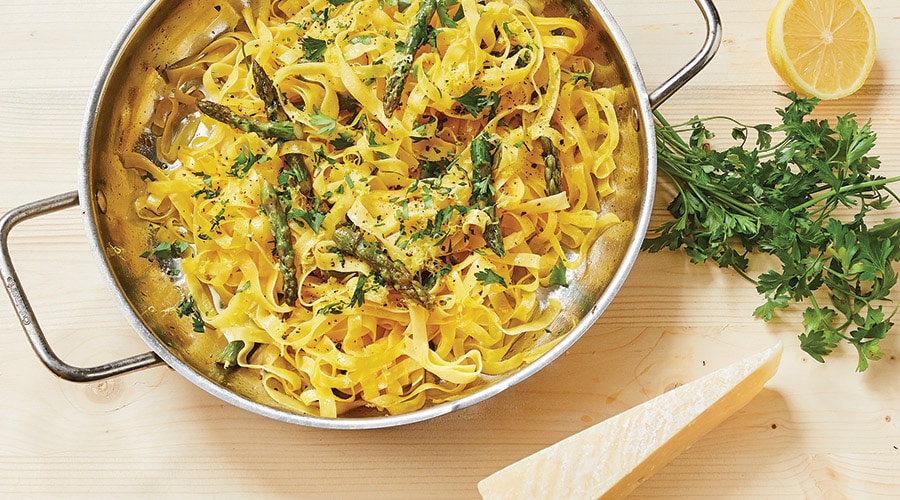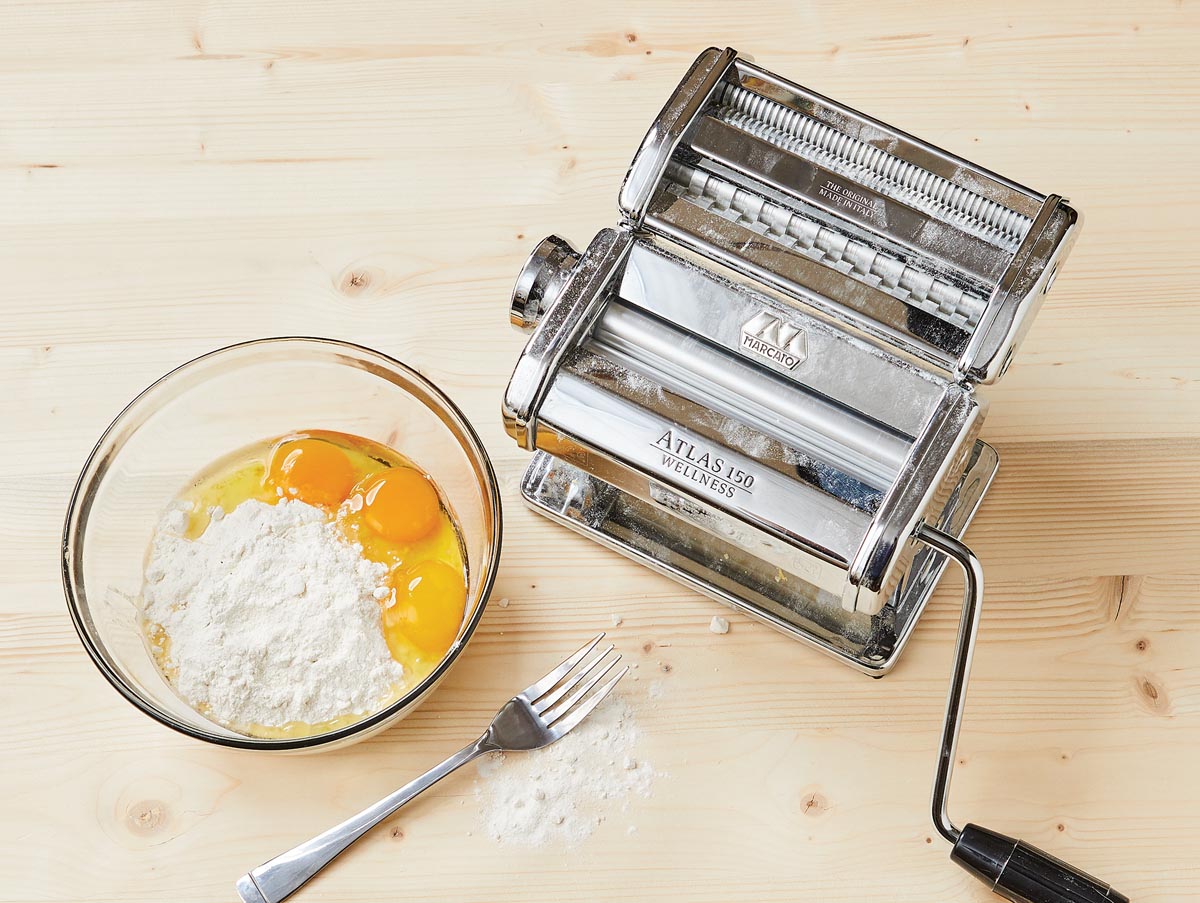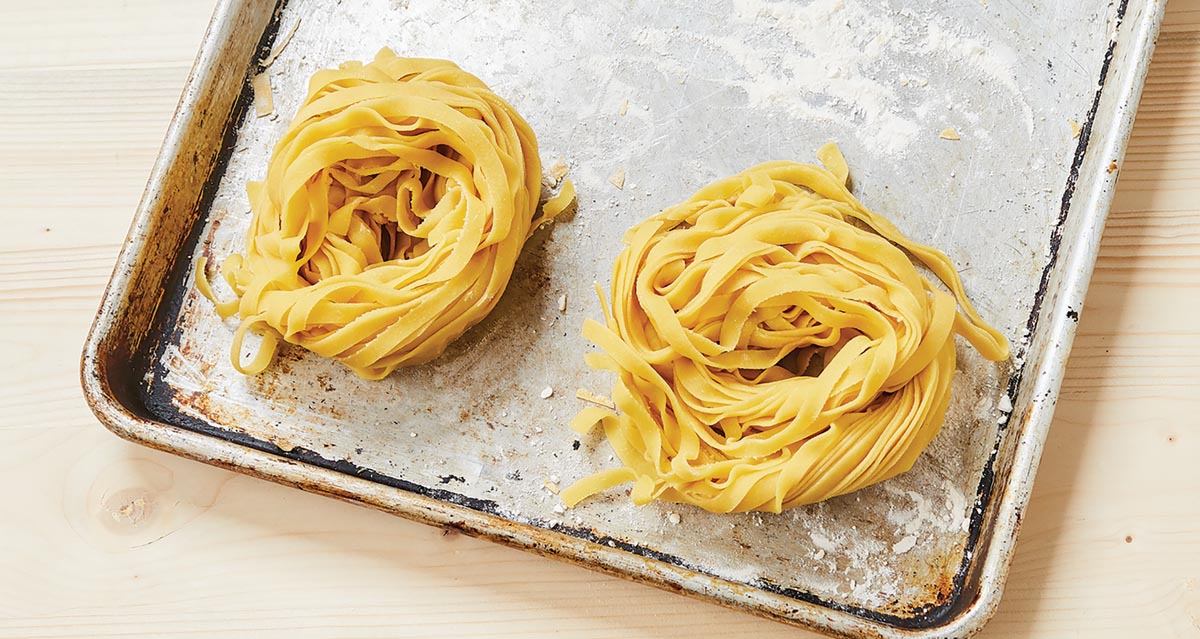
HOME MADE
By Michael Hiller
Instead of reaching for that bag of dried noodles, pull out that pasta machine that has been sitting in your pantry and make your own. Combine flour, water, eggs and a pinch of salt in a bowl, knead dough a bit, then crank it through the rollers of a pasta machine a few times, and you’ve got thin sheets of dough that can be cut into fettuccine or tagliatelle, or formed into dozens of other shapes. Still hesitant? We asked homegrown pasta whiz Stefano Secchi, whose family owns Ferrari’s Italian Villa & Chop House in Grapevine and Addison, for some pro tips on making a simple spring dish: fresh tagliatelle pasta tumbled with asparagus and lemon. Your first effort might not have the finesse of Secchi’s handiwork, but trust his advice.
Secchi’s handiwork, but trust his advice. His pasta-focused restaurant in New York City, Rezdôra, has garnered top-tier reviews from The New York Times, The New Yorker and a dozen other prominent publications. “In Liguria, a rocky coastal town in northwest Italy where tagliatelle was invented, you’ll see lemons and asparagus everywhere this time of year,” Secchi says. “At Rezdôra, we make half-moon pastas filled with ricotta, lemon zest and aged Parmigiano-Reggiano, and then serve them with a walnut sauce everyone in Liguria knows how to make.
This version is even easier, and asparagus is in season in Texas right now. If you don’t like asparagus, use a spring vegetable you do like. If you don’t have parsley, go with thyme. Or if you have a container of fresh pesto from Central Market, Sam’s or Costco in the refrigerator, use that. The only thing you can’t tinker with is the grated cheese. You have to finish the dish with authentic Parmigiano-Reggiano, because that’s how we do everything in Italy.”
Tagliatelle with Asparagus and Lemon
Makes 2 large servings
• 1½ cups flour, divided
• 4 eggs (3 separated)
• Sea salt
• ½ pound asparagus
• 1 large lemon
• ½ cup butter
• ½ cup Italian parsley, chopped
• ½ cup ricotta
• ½ cup Parmigiano-Reggiano, grated
• Black pepper
Pasta Combine 1 cup of flour, one whole egg and three yolks in a bowl and mix by hand. Once the dough forms into a ball, place it onto a lightly floured countertop and knead until smooth and elastic, about 8 minutes. (Alternatively, you could mix the ingredients in a food processor for about 60 seconds.) If the dough is too stiff, knead in a teaspoon of water. If it’s too sticky, add a teaspoon of flour.
Once it is smooth and elastic, shape the dough into a ball and wrap in plastic or place into a zip-top plastic bag to rest for at least 30 minutes (or up to 2 days) in the refrigerator.
Unwrap the dough, then place on lightly floured surface; flatten slightly. Cut dough into 4 pieces. Rewrap three dough pieces in plastic wrap and set aside.
Set rollers of the pasta machine to their widest setting. Feed the unwrapped dough through the rollers by turning the handle. You will do this several times. Don’t worry if the first pass or two creates a crumbly sheet of dough.
Lightly flour the rough sheet, fold it into thirds and feed it through rollers two or more times until the dough feels smooth and elastic.
Narrow the machine’s rollers by 1 notch. Feed the dough sheet through rollers. Without folding it into thirds, roll into increasingly thinner settings, stopping when you’ve rolled the sheet through the machine’s second-to-the-last position. Let dough rest on a lightly floured surface about 5 minutes to dry slightly.
Now feed the sheet through the thinner of the two cutters of your machine. That will make tagliatelle. Repeat kneading and rolling with reserved dough pieces. Twirl the pasta strands into fist-size nests, then place them onto a floured cookie sheet to rest up to 2 hours, until you’re ready to cook them.
Sauce Bring a large pot of salted water to boil. “Use more salt than you think you should,” Secchi says. “The water should taste as salty as the sea, which is why we prefer sea salt instead of kosher or table salt.”
Trim the asparagus and cut the tender tops into bite-size pieces. Set aside.
Zest the lemon. Cut in half and squeeze the juice into the bowl. Set aside.
Over medium-high heat, melt the butter in a large saute pan. Once the butter is foamy, add asparagus and a big pinch of salt. Cook, stirring frequently, until the asparagus turns bright green, about 3 minutes. Add a teaspoon of lemon zest and the lemon juice; stir to combine. Taste and add salt and zest as desired. Remove from heat and set aside.
Cook the pasta until barely tender, about 2 minutes. Drain, reserving a half-cup of the pasta water. Do not rinse the pasta; the surface starch helps create a creamy pan sauce. Return skillet to medium heat and add the drained pasta to the asparagus mixture. Using tongs or a fork, gently tumble and swirl everything together for about 30 seconds. Add some of the reserved pasta water, a tablespoon or two at a time, to thin the sauce.
To serve, divide the pasta between 2 plates or bowls. Sprinkle with the grated Parmigiano-Reggiano, parsley and freshly ground black pepper. Add a final sprinkle of lemon zest and lemon juice; serve immediately.



